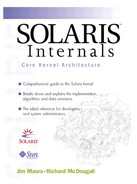1.9. I/O Architecture
Traditional UNIX implements kernel-resident device drivers to interface with hardware devices. The device driver manages data transfer and registers I/O and handles device hardware interrupts. A device driver typically has to know intimate details about the hardware device and the layout of buses to which the device is connected. Solaris extends traditional device driver management functions by using separate drivers for devices and buses: a device driver controls a device's hardware, and a bus nexus driver controls and translates data between two different types of buses.
Solaris organizes I/O devices in a hierarchy of bus nexus and instances of devices, according to the physical connection hierarchy of the devices. The hierarchy shown in Figure 1.9 represents a typical Solaris device tree.
Figure 1.9. The Solaris Device Tree

Each bus connects to another bus through a bus nexus. In our example, nexus drivers are represented by the PCI, EISA, PCMCIA, and SCSI nodes. The SCSI host adapter is a bus nexus bridging the PCI and SCSI bus it controls, underneath which the SCSI disk (sd) device driver implements device nodes for each disk on the SCSI chain.
The Solaris device driver interface (DDI) hides the implementation specifics of the platform and bus hierarchy from the device drivers. The DDI provides interfaces for registering interrupts, mapping registers, and accessing DMA memory. In that way, the kernel can interface with the device.
Device drivers are implemented as loadable modules, that is, as separate binaries containing driver code. Device drivers are loaded automatically the first time their device is accessed.
